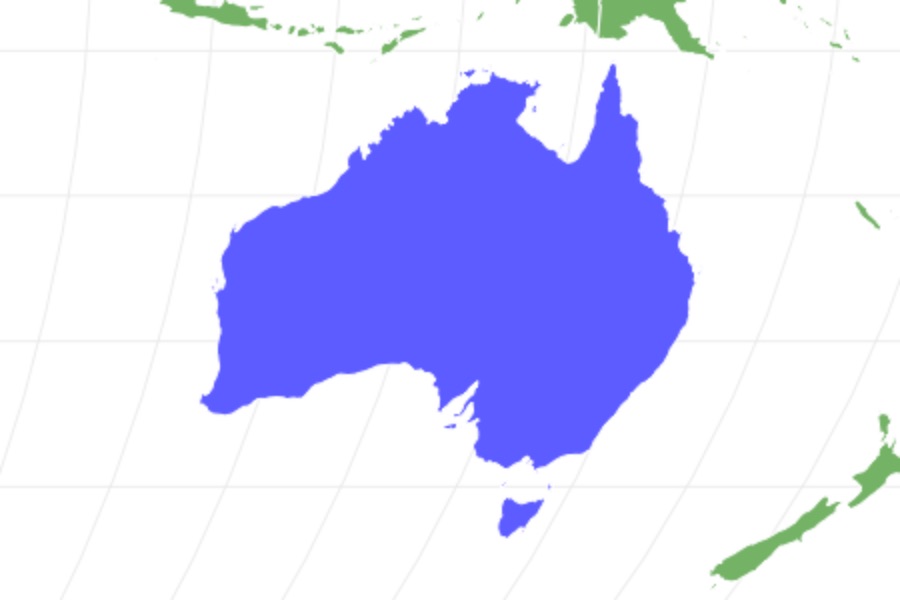Platypus
Ornithorhynchus anatinus
The first specimen seen in Europe was thought to be fake!
Advertisement
Platypus Scientific Classification
- Kingdom
- Animalia
- Phylum
- Chordata
- Class
- Mammalia
- Order
- Monotremata
- Family
- Ornithorhynchidae
- Genus
- Ornithorhynchus
- Scientific Name
- Ornithorhynchus anatinus
Read our Complete Guide to Classification of Animals.
Platypus Conservation Status
Platypus Facts
- Prey
- Insect larvae, tadpoles, small fish
- Name Of Young
- Baby Platypus
- Group Behavior
- Solitary
- Fun Fact
- The first specimen seen in Europe was thought to be fake!
- Estimated Population Size
- 30,000 - 300,000
- Biggest Threat
- Habitat loss
- Most Distinctive Feature
- Bill that looks like the beak of a duck
- Other Name(s)
- Duck-Billed Platypus
- Gestation Period
- 1 - 2 Weeks
- Habitat
- Freshwater rivers and streams
- Predators
- Birds of prey, dogs, crocodiles
- Diet
- Carnivore
- Average Litter Size
- 2
- Lifestyle
- Nocturnal
- Common Name
- Platypus
- Number Of Species
- 1
- Location
- Eastern Australia and Tasmania
- Slogan
- One of the only mammals to lay eggs!
- Group
- Mammal
Platypus Physical Characteristics
- Color
- Dark Brown
- Skin Type
- Fur
- Top Speed
- 22 mph
- Lifespan
- 17 years
- Weight
- 0.7kg - 2.4kg (1.5lbs - 5.3lbs)
- Height
- 39cm - 60cm (15.4in - 23.6in)
- Age of Sexual Maturity
- 2 years
- Age of Weaning
- 5 months
View all of the Platypus images!
Classification, Evolution, and History
The platypus (also commonly known as the duck-billed platypus) is a small species of semi-aquatic mammal indigenous to the eastern coast of Australia. Known for its unique-looking appearance, the platypus belongs to a small group of mammals called monotremes, of which there are only a few species.
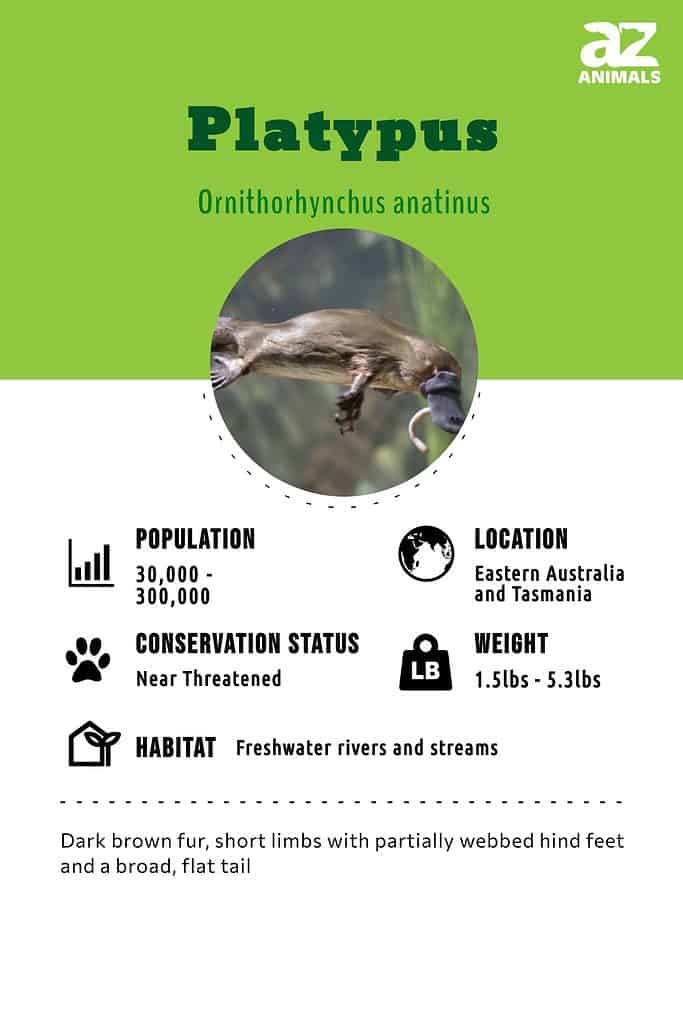
The platypus along with the short-nosed echidna and long-nosed echidna are the only mammals that are known to lay eggs instead of giving birth to live young, making them truly unique and leading to them not being recognized as true mammals for a long time. They do, however, possess and feed their young using their mammary glands – the essential characteristic from which the class Mammalia takes its name. When the first platypus specimen arrived in Britain in 1798, it was thought to be a hoax as the platypus looks like it is a mixture of a mammal and a bird.
There appears to be some evidence that, while platypuses now live in the freshwaters of Australia, they once lived in more locations, including South America! This was possible because of the geographical connection of Australia to South America via Antarctica millions of years ago.
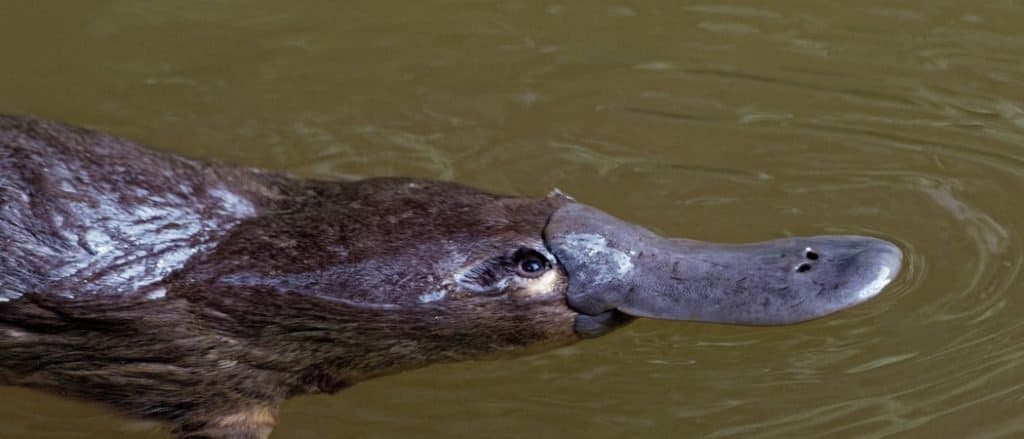
The platypus is one of the few species of monotremes and is easily identified by its ducklike nose.
©iStock.com/phototrip
Anatomy and Appearance
The platypus is an animal with a small, streamlined body that is covered in short and dense waterproof fur that varies in color from dark brown on its back with a light brown or silver underside and a plum-colored middle. They have short limbs with partially webbed hind feet and a broad, flat tail (which resembles the tail of a beaver) that are used as rudders when underwater. Their front feet are fully webbed and help to propel the platypus through the water and can be turned back when on land, exposing their large nails to aid them when walking or burrowing into the river banks. One of the platypus’s most distinctive and unusual features is the large, broad bill that looks like the beak of a duck. The bill of the platypus is soft and pliable and covered in a multitude of sensory receptors that help them to detect the small electrical signals emitted from their prey species. Their bills are very touch-sensitive and are often used to probe the mud on the riverbed for the small insect larvae on which they most commonly feed on. Males are larger in size than females and possess a poison spur on the ankle of each hind foot that is used to drive away rival males during the breeding season. Learn more about the most venomous mammals on earth here.
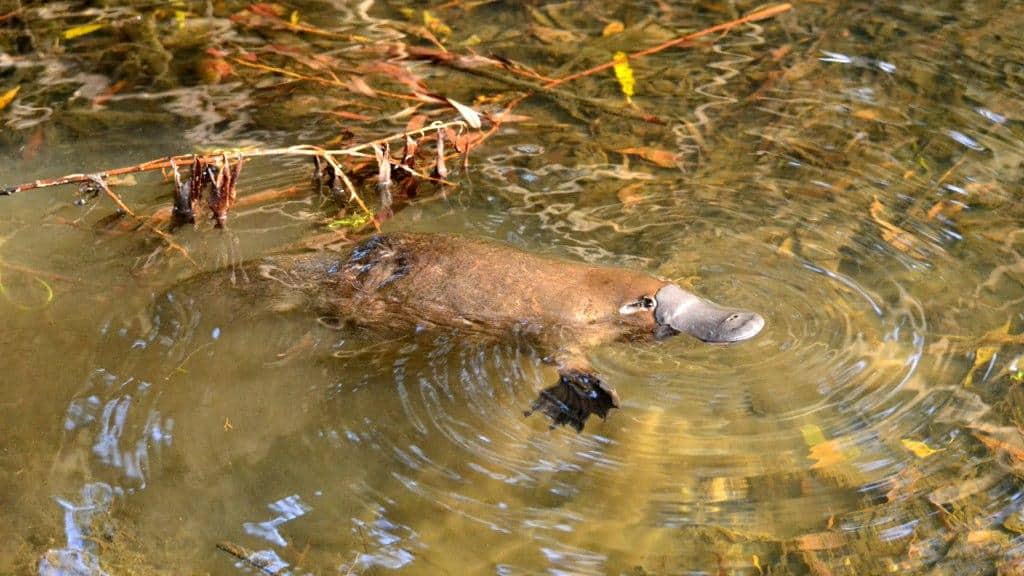
Platypuses have short limbs with partially webbed hind feet and a broad, flat tail.
Distribution and Habitat
The platypus is an animal that is found on the east coast of Australia from Cooktown in Queensland in the north, all the way down to the island of Tasmania in the south and has also been introduced to Kangaroo Island in southern Australia. They inhabit streams and rivers, and some lakes that have suitable banks for burrowing in and a permanent source of water. They are highly suited to their semi-aquatic environment and possess the best physical characteristics for dealing with life both in and out of the water, with their dense fur helping to keep their warm bodies insulated even in the coldest of water. Their home ranges vary depending on the specific river system and can vary in size from less than a kilometer to more than 7 kilometers, and overlap those ranges of other individuals despite their solitary nature. The platypus is thought to be so successful as an animal species as they are able to survive in such a niche environment in the world’s driest continent.
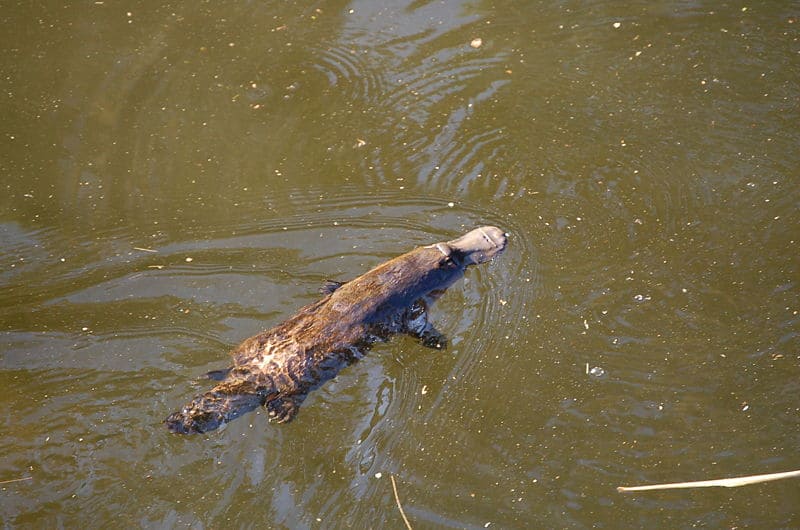
Platypuses inhabit streams, rivers, and some lakes that have suitable banks for burrowing in and are a permanent source of water.
Behavior and Lifestyle
The platypus is a solitary animal that despite occupying overlapping home ranges, only comes together during the breeding season or when a mother is looking after her young. They are nocturnal hunters that are able to close their eyes, ears, and nostrils when diving down to the river bed in search of food. During the day, they rest in burrows that are dug into the river banks using their long, broad nails and powerful front legs. There are two different types of burrows used by the platypus; one for resting and one for incubating their eggs and nursing their young. Individual animals may use a number of resting burrows within their home range. Typically resting burrows are around 5 meters in length but incubation burrows can reach up to 30 meters long and can have more than one nesting chamber.
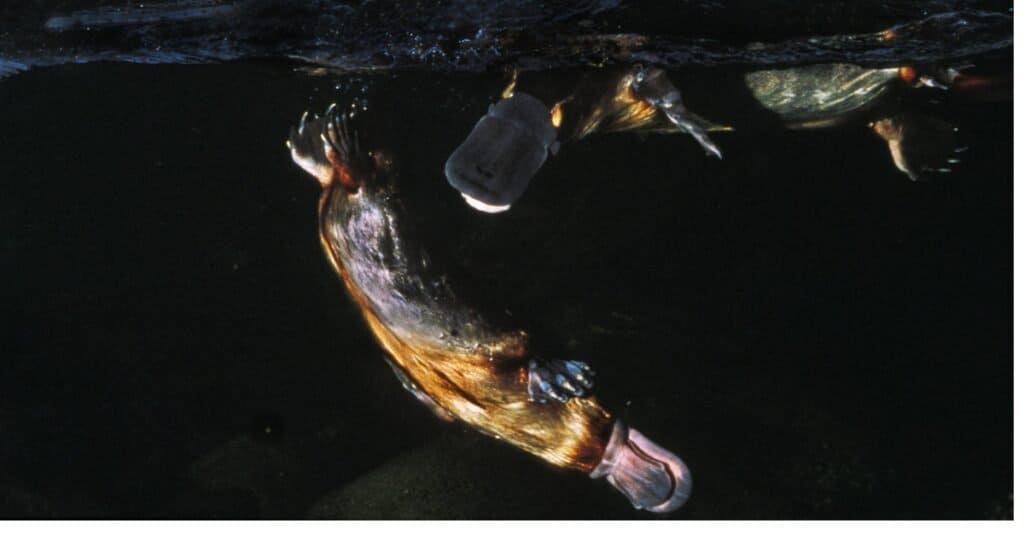
Normally solitary animals, platypuses only come together when breeding or when mothers are rearing their young.
©iStock.com/slowmotiongli
Reproduction and Life Cycles
Breeding takes place between late winter and early spring (July – October) in the water, with males using their poison spurs to deliver a painful dose of poison to their rivals. As part of their courtship ritual, females carry bundles of wet leaves to their incubation chamber at the end of their burrow and plug the tunnel with soil. After a gestation period of between two and three weeks, the female platypus lays between one and three small, spherical eggs that are only 1.5 cm in size and are soft and leathery. After an incubation period of around 10 days, the young hatch out in a very undeveloped state measuring barely 1 cm in length, blind, hairless, and having blunt buds for limbs. They are nursed by their mother in the incubation chamber for up to 5 months suckling on the milk on her fur that is secreted by her mammary glands. A young Platypus is lighter in color than older individuals and 85% of their adult size when they first become independent. Platypuses tend to live for around 10 years in the wild but can reach ages of 17 or more when in captivity.
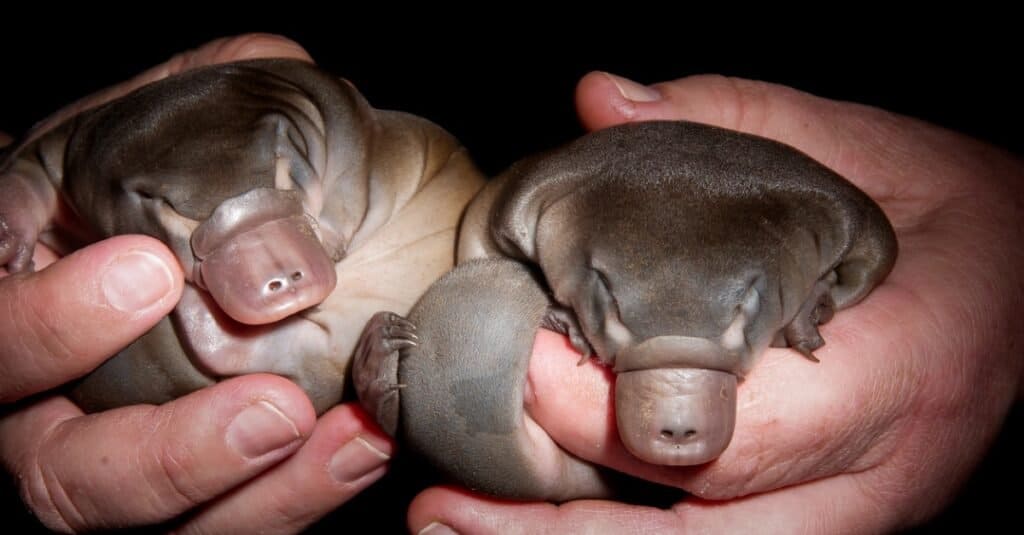
Platypuses hatch from soft, leathery eggs.
©iStock.com/IainStych
Diet and Prey
The platypus is a small, carnivorous mammal whose diet is almost solely comprised of bottom-dwelling aquatic creatures. Young insects (larvae) make up the majority of their diet along with small freshwater crustaceans, snails, tadpoles, and small fish. Due to the fact that their eyes, ears, and nostrils are closed when they are underwater, the platypus relies solely on its bill in order to find food. The small sensory receptors that cover it can detect the electrical signals created by the movement of creatures in the water and the fact that it is highly tactile means that they can also feel prey species when probing the mud on the river bed. When hunting the platypus stores food in cheek pouches located on the sides of the mouth that is then ground up using the horny ridges that the platypus has instead of teeth.
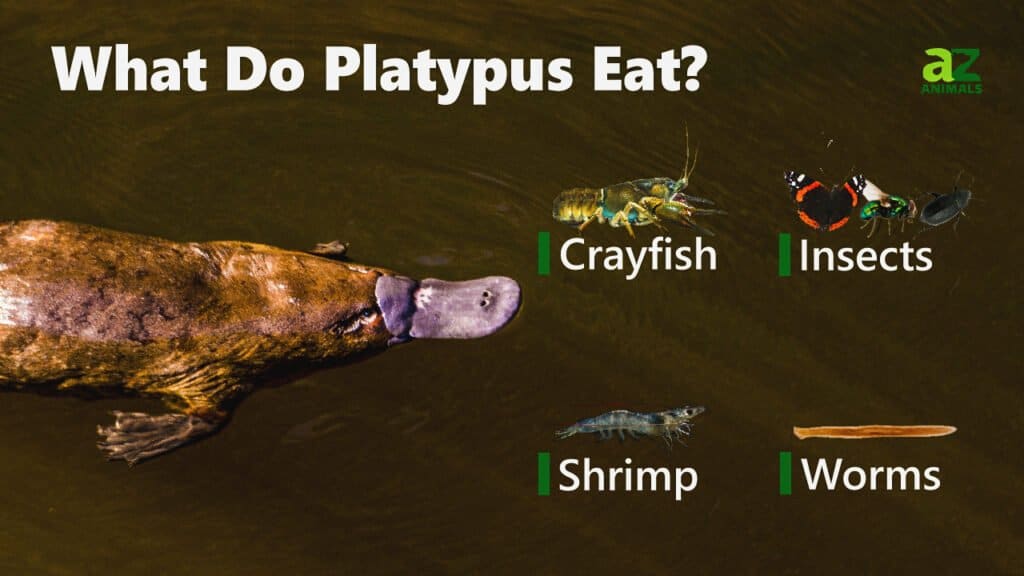
Predators and Threats
The platypus is a highly specialized animal that has evolved to survive and thrive in very specific environments and protects itself from predators when resting during the day by hiding in its river-bank burrows. However, their small size means that they are preyed upon by numerous animal species throughout their home ranges. Their most common predators include birds of prey such as hawks and eagles, large mammals including dingoes, dogs, cats, and Tasmanian devils, and reptiles such as snakes, monitor lizards, and crocodiles. Despite the fact that they are widespread and considered locally common in places, they were hunted to near extinction in the 18th century which has led to reductions and fragmentation of platypus populations in some areas. Due to their very specific evolution, they are also highly susceptible to changes in their natural habitats.
Platypus Interesting Facts and Features
The platypus is a species of monotreme, which is a small group of egg-laying mammals of which are they are only three species. Not considered true mammals by some scientists, monotremes are thought to be the most primitive group of mammals having evolved around 200 million years ago. However, despite having evolved before other mammal species, monotremes are by no means primitive and possess some highly developed features that are not found in any other group of mammals, such as the poisonous spur found on the hind ankles of males. Unlike other mammals, they do not have a birth canal and instead, their eggs travel through the same bodily opening as their urine and feces and terminate in a single bodily opening known as the cloaca. This is a feature that monotremes share with both birds and reptiles with the name monotreme actually meaning “one-holed animal”.
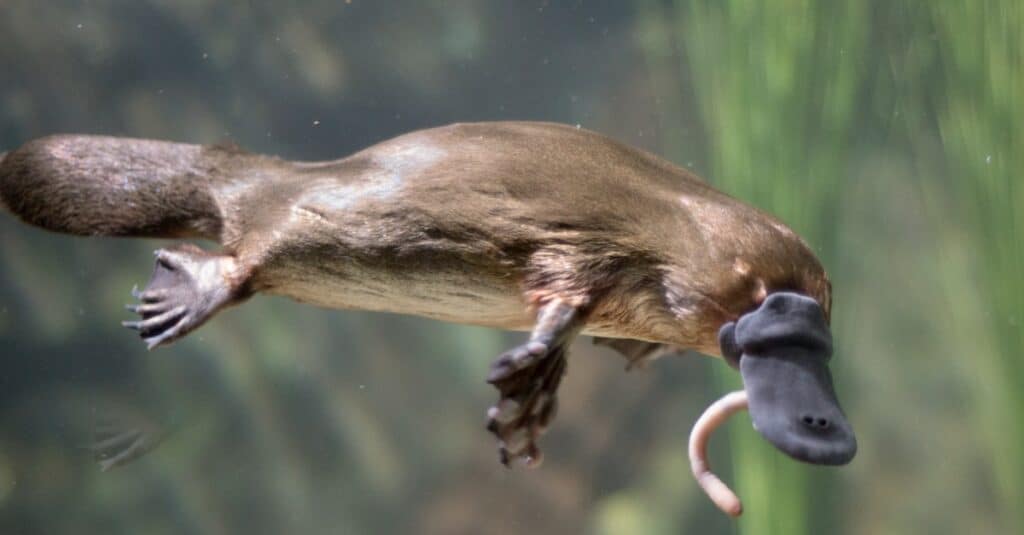
Platypuses have evolved to have features that are not found in any other group of mammals.
©iStock.com/JohnCarnemolla
Relationship with Humans
With the settlement of Europeans in the 18th century came a great change for platypus populations along Australia’s eastern coast. The platypus was hunted extensively for its soft, thick fur until it became banned in 1900 which allowed populations to begin to recover. Growing human settlements and changes to the freshwater conditions caused by pollution has had a negative impact on platypus populations particularly in certain areas, where they have suffered from habitat loss.
Conservation Status and Life Today
Until 2014, the platypus was considered to be an animal that was of Least Concern from extinction by the IUCN. However, due to the constant decline in their population numbers, they are considered to be a species that is now Near Threatened. With up to 300,000 adult individuals remaining in the wild, the platypus is becoming increasingly threatened throughout its natural range. A number of captive breeding programs have been established to try and boost platypus population numbers in certain areas.
View all 192 animals that start with PPlatypus FAQs (Frequently Asked Questions)
Are Platypuses herbivores, carnivores, or omnivores?
Platypuses are Carnivores, meaning they eat other animals.
What Kingdom do Platypuses belong to?
Platypuses belong to the Kingdom Animalia.
What phylum do Platypuses belong to?
Platypuses belong to the phylum Chordata.
What class do Platypuses belong to?
Platypuses belong to the class Mammalia.
What family do Platypuses belong to?
Platypuses belong to the family Ornithorhynchidae.
What order do Platypuses belong to?
Platypuses belong to the order Monotremata.
What genus do Platypuses belong to?
Platypuses belong to the genus Ornithorhynchus.
What type of covering do Platypuses have?
Platypuses are covered in Fur.
Where do Platypuses live?
Platypuses live in Eastern Australia and Tasmania.
In what type of habitat do Platypuses live?
Platypuses live in freshwater rivers and streams.
What are some predators of Platypuses?
Predators of Platypuses include birds of prey, dogs, and crocodiles.
What is the average litter size for a Platypus?
The average litter size for a Platypus is 2.
What is an interesting fact about Platypuses?
Platypuses are one of the only mammals to lay eggs!
What is the scientific name for the Platypus?
The scientific name for the Platypus is Ornithorhynchus anatinus.
What is the lifespan of a Platypus?
Platypuses can live for 9 to 12 years.
How many species of Platypus are there?
There is 1 species of Platypus.
What is the biggest threat to the Platypus?
The biggest threat to the Platypus is habitat loss.
What is another name for the Platypus?
The Platypus is also called the duck-billed platypus.
How many Platypuses are left in the world?
There are 300,000 Platypuses left in the world.
How fast is a Platypus?
A Platypus can travel at speeds of up to 22 miles per hour.
What is the difference between a platypus and a beaver?
The greatest differences between a platypus and beaver lie in their size, morphology, and reproduction. Beavers are far larger than platypuses, weighing over 10 times as much and doubling their overall length.
How to say Platypus in ...
Thank you for reading! Have some feedback for us? Contact the AZ Animals editorial team.
Sources
- David Burnie, Dorling Kindersley (2011) Animal, The Definitive Visual Guide To The World's Wildlife
- Tom Jackson, Lorenz Books (2007) The World Encyclopedia Of Animals
- David Burnie, Kingfisher (2011) The Kingfisher Animal Encyclopedia
- Richard Mackay, University of California Press (2009) The Atlas Of Endangered Species
- David Burnie, Dorling Kindersley (2008) Illustrated Encyclopedia Of Animals
- Dorling Kindersley (2006) Dorling Kindersley Encyclopedia Of Animals
- David W. Macdonald, Oxford University Press (2010) The Encyclopedia Of Mammals

